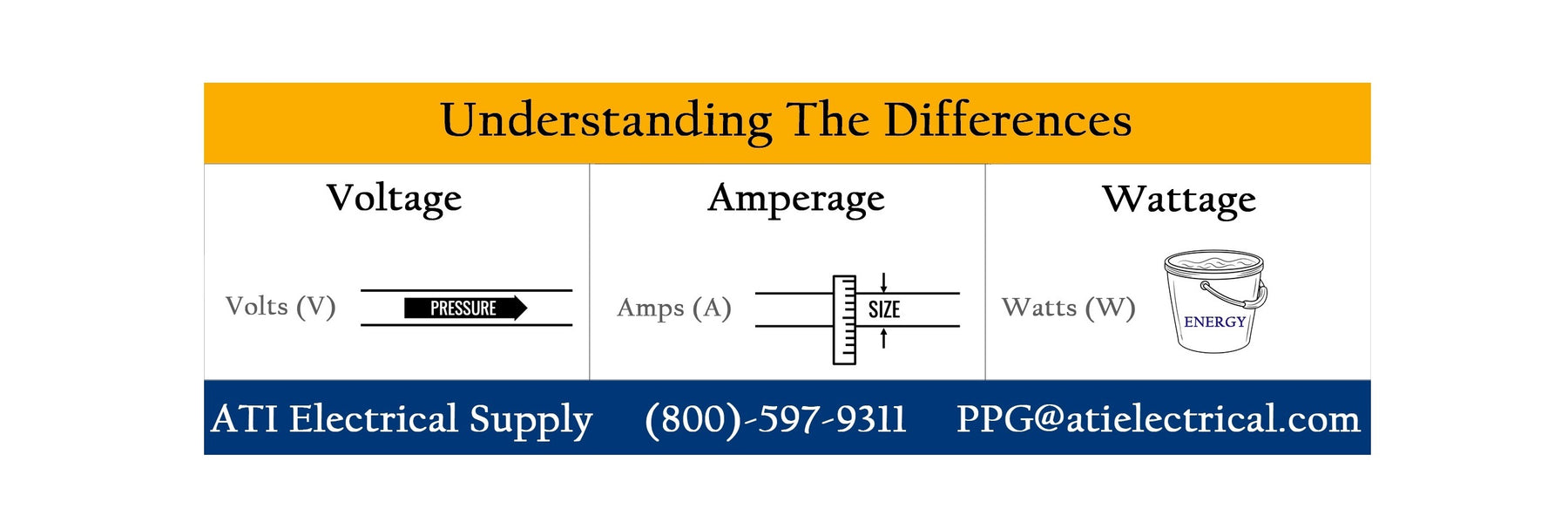
Understanding the Difference Between Voltage, Amperage, and Wattage
We’ve all had a lightbulb burnout at least once or twice in our lifetime, right? This often leads you to take a trip to your local hardware store for a replacement, but have you ever wondered what a 60-watt light bulb actually means? For instance, do you know the difference between a 25, 40, and 60-watt bulb?
Well, to put it into simple terms, wattage is the total amount of energy that a single piece of equipment (such as the lightbulb) consumes. For example, a 60-watt light bulb will consume more than twice the amount of power than that of a 25-watt bulb, and therefore will emit more light.
Understanding Amperage, Voltage, and the number of Watts that a piece of equipment consumes is so important to ensure there are no safety hazards or concerns associated with your electrical equipment. Also, understanding these factors can help you save time and money by allowing you to determine the best electrical solution for your application. In this blog, I will explain the difference between amperage, voltage, and wattage and where each one coincides.
What is Amperage (A)?
If you’ve ever looked inside your electrical panel at home, you would see circuit breakers labeled 15A, 20A, 30A, 50A, and so on. The “A” in these circuit breakers represents Amperage and is there to inform you of the number of Amperes allowed before the circuit breaker will trip to ensure there is no excessive heat buildup throughout the circuit.
Amperage is a measurement of the total electrical current that is flowing through a specific circuit. This electrical current is monitored and limited by the circuit breaker. Generally, when a circuit exceeds 80% of the total rated amperage, the breaker will open the circuit which stops the flow of electrical current to prevent any safety hazards.
Without the help from a circuit breaker or a fuse, amperage cannot be measured properly and could unexpectedly exceed the safe operating limit (80%), which can result in wires heating up and melting. If this is not addressed as soon as possible, this can start an electrical fire. Therefore, it’s so important to understand how Amperage works and how it’s measured.
What is Voltage (V)?
Simply explained, voltage is the amount of power required to operate a piece of equipment such as an air conditioner, television, or a light. In more technical terms, voltage is the buildup of pressure from a power source that forces electrical current to move through a conducting loop, also referred to as an electrical circuit. It's the electrical force that drives electrons (electrical current) between two points in a circuit.
Some devices like your A/C unit will require more voltage (electrical pressure) to be powered on than that of a television because the air conditioner is obviously much larger, and its motor will consume more energy, therefore needing more electrons and amperes to operate properly.
What is Wattage (W)?
Now that we have a brief understanding of voltage, amperage, and how these two relate to one another, let’s review watts. As mentioned previously, A watt is the total amount of energy that a piece of equipment consumes. It’s also how your local utility company calculates how much energy you’re using at your place of residence in order to accurately bill you each month. It’s generally calculated by each 1000 watts that are used, which is equivalent to 1 Kilowatt.
Let’s put this into perspective. If you have a lightbulb operating at 60 Watts and 120 Volts, you can determine by the formula A=W/V that this lightbulb is putting out half an amp (0.5A). So, if this is a 15-Amp circuit then it's possible to operate approximately 24 lights at 60-watts each before the circuit breaker will trip at an 80% rating. I’ve verified this by multiplying the ampacity of the light by the total number of lights (0.5 * 24) equaling 12 Amps, which is 80% of 15 Amps.
Wattage is a great concept that you can grasp to help you verify the correct operating ampacity and confirm that equipment is operating under safe conditions. Let’s look at another example. If you have a device and the manufacturer’s label indicates that it draws 2,500 watts, then you need to figure out how to properly size your circuit breaker for that device. Depending on the operating voltage, you can have different calculations. Using the formula, A=W/V, we can establish the following:
For 220V, we can determine the device will operate at: 2,500 / 220 = 11.36 Amps, therefore indicating we should size our circuit breaker at 15 Amps.
For 120V, we can determine the device will operate at: 2,500/120 = 20.83 Amps, therefore indicating we should size our circuit breaker at 30 Amps.
Need Calculations for Your Equipment?
ATI’s goal is to ensure our customers are provided with the knowledge, tools, equipment, and power solutions that they need at the first go around. We try to educate our customers at every chance we get to minimize mistakes on orders and guarantee you that you’re in great hands! If you have any further questions regarding Voltage, Amperage, or Wattage, please don’t hesitate to reach out to our experts for a deeper understanding by calling or texting us at (800)-597-9311 or you can email us at PPG@ATIelectrical.com.
Our job is to go above and beyond for our customers, whether that means putting in the extra hours to source products that you need or even helping with amperage and wattage calculations for an upcoming event. ATI is at your service! If you find yourself on our website, you can also chat with a live customer support representative on our website Monday – Friday from 9:00 A.M. to 5:00 P.M EST.



 CALL OR TEXT NOW 800-597-9311
CALL OR TEXT NOW 800-597-9311
Leave a comment